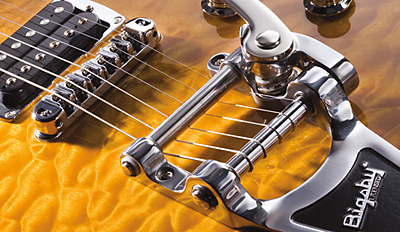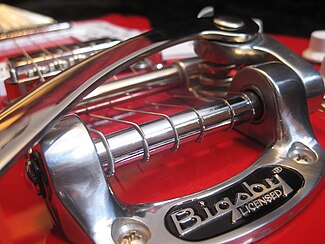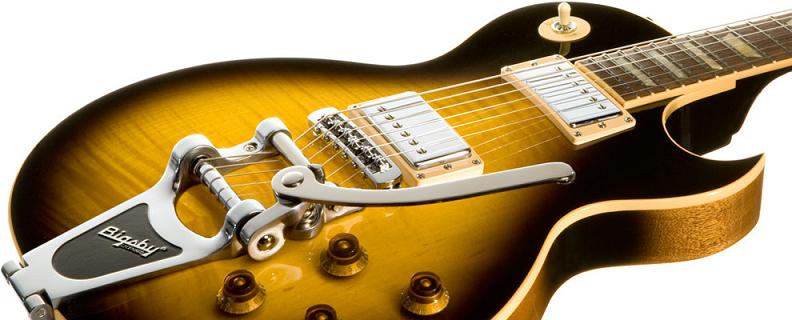Bigsby vibrato tailpiece
Bigsby Guitars is an American company that has specialized in the production of guitar accessories, especially the vibrato. The company was founded in the 1940s by Paul Bigsby Adelburt ( 1899-1968 ) in Downey (Los Angeles County ), California for the production of electric guitars and Lapsteels. Founder Paul Bigsby was one of his early instruments of the pioneers of the electric guitar construction and influenced by his ideas, inter alia, Leo Fender.
History
The company " Bigsby Guitars" goes back to the " Crocker Motorcycle Company ", a motorcycle manufacturer, in the Paul Bigsby as a mechanic and developers since the 1930s worked. Bigsby, who boasted themselves to be able to fix everything, came as a fan of country music in the 1940s in contact with the musician Merle Travis, a customer of Crocker. Travis reported problems with the Bigsby vibrato system worn his Gibson L-10 guitar, whereupon Bigsby developed a new vibrato for the guitar. The heart of the vibrato was a rotatably mounted steel shaft around which the strings are wrapped. This new vibrato enabled uniform pitch swings in both directions and could be installed on almost all archtop guitars of the time instead of the tailpiece. From the 1950s Bigsby vibrato were offered as standard equipment from companies such as Gretsch and Gibson on their guitars, as well as by Bigsby upgrade kit for guitar without vibrato.
In 1946, reported Travis Bigsby from the idea to create a new electric guitar. The guitar should have a flat, partially solid body to avoid unwanted feedback. The hitherto conventional electric guitars still possessed the hollow body of the acoustic guitar, which is why they are very easy fielded the sound waves of the amplifier and produced noise. In addition, the guitar should have an asymmetric head plate, on which the six voice mechanisms should be placed in a line. Travis hoped against the traditional symmetric "3- left -3 right " arrangement a more comfortable votes and greater tuning stability. Next, the body should have a cutaway to improve the playability of the high frets. Bigsby made on a first specimen of this design, the first Bigsby / Travis guitar, mid-1948 after sketches by Travis. Bigsby quickly received orders for other instruments, according to the Travis used the guitar regularly at live concerts and radio appearances. In the aftermath Bigsby vibrato stood next to her e- guitars, electric mandolins, Lapsteels and various double-neck guitar, the guitar and mandolin combined. Next Bigsby worked to order the top plates of conventional acoustic guitars on the new asymmetrical shape around.
In 1965, the health of Paul Bigsby was deteriorating rapidly, so he gave up the instrument production and concentrated on the production of vibrato. 1966 Bigsby sold his company to the former Gibson President Ted McCarty, who led the company until his death in 2001. Paul Bigsby died 1968. 1999 took over the Fred Gretsch Company, Inc., the company Bigsby, which in turn is part of the Fender Group. The production of vibrato are primarily used place in the USA, which now also manufacture other companies in other countries Bigsby vibrato. Distinguishing feature is often the patent number on the American original, which will be replaced with the replicas by the words " Licensed by " in the same font.
Merle Travis Guitar
→ Main article: Bigsby / Travis guitar
The Merle Travis Guitar was made largely of maple and had a through- neck with pickled steel rod. At the sides of two partially hollow wings were attached, which housed the electronics. The guitar had a single-coil pickups and knobs and a switch to change the sound. The fretboard was rosewood and had as markers mother of pearl inlays in the form of playing cards symbols. The large asymmetric top plate had six mounted in series tuners and a saddle made of metal. How many instruments of this type were prepared is not known. It is likely, however, that Bigsby, who made the instruments made to order by hand, has built up to 1965 not more than 100 instruments including e- mandolins and Lapsteels. The original from 1948 is now in the Country Music Hall of Fame in Nashville, Tennessee.
The Bigsby Merle Travis - guitar is now regarded as one of the first modern electric guitars, as they anticipated many structural details of the later solidbody instruments. It is commonly believed that Leo Fender, whose radio, only a few miles away was especially in Fullerton, was influenced by the design of the Merle Travis - guitar. Although Leo Fender life denied any connection, is now considered certain that he knew the instruments of Bigsby. Fender, who has already produced successful music amplifier in the 1940s and repaired, was present as a technician at many concerts in California. There also came to meeting with Merle Travis. Travis even claimed that he had borrowed the Bigsby guitar after a concert for a few days to Leo Fender at his request. In exchange, he allegedly received an early prototype of the Fender Telecaster to the view. In fact, the first prototypes of the Telecaster a symmetrical headstock with "3- left -3 right " arrangement of the tuners on the fenders in favor of an asymmetric " 6 -in-row " arrangement similar rejected the Bigsby guitar shortly before the start of production in 1950.
Bigsby vibrato
The Bigsby vibrato was one of the first tremolo systems until now widespread. Especially on guitars in the Gretsch Company, but also on instruments from Gibson, Fender, Rickenbacker and Bigsby vibrato the other was offered as standard or retrofitted. Vibrato itself consists of a base plate of solid aluminum in which a steel shaft is mounted rotatably. The strings are wound around the steel shaft, which was also the vibrato arm is attached. If you move the whammy bar, the strings are wound or unwound and the pitch changes according to the fluctuating string tension. The Bigsby vibrato allows slight variations in pitch by about 1-2 semitones. The string tension is opposed by a solid spring, originally from the engine of a Harley -Davidson motorcycle. The spring is still located in the spare parts program from Harley Davidson. The most common types of the Bigsby vibrato are:
- B 3 - Bigsby vibrato with trapezoidal base. B 3 may be attached to the rear strap button of a guitar and is then fixed only by the pressure of the strings. Since, on the ceiling of the guitar no further holes must be made, the B 3 is very popular as a retrofit. The B 3 can be found in different models mainly on Gretsch guitars.
- B 5 - A smaller version of the B 3 with a circular base plate and low-pressure role. The B 5 is also called " Horseshoe " ( horseshoe ) of musicians because of its appearance. The B 5 is suitable Telecaster due to its small, compact design for installation on flat solid body guitars like the Gibson SG or Fender.
- B 7 - Great version of the B 3 with additional low-pressure role for the strings. Due to its size, the B 7 is frequently installed on semi- acoustic jazz guitar in the style of the Gibson ES -335.
A disadvantage of the system to the vibrato Fender is the extremely limited range in which the pitch can be changed. In addition, it often does not completely detuning free.
Bigsby in music
The Bigsby guitars and Lapsteels can only be heard on a few recordings of the 1950s, as they were quickly displaced by the instruments of the company Fender. In addition to Merle Travis, among others played Jimmy Bryant and Grady Martin Guitars by Bigsby, the latter also a double-neck guitar. The Lapsteels were, inter alia, used by Speedy West.
More common than the instruments are the Bigsby vibrato that allow it due to their construction, the guitar add a characteristic " shimmer ". This sound is used primarily in those stylistics, in which the guitar sound is little or not distorted as in jazz, blues and rock 'n ' roll. Clips can be found both in Country musicians such as Chet Atkins and Duane Eddy to the rockabilly punks the Stray Cats. John Lennon had a Bigsby B5 vibrato mount in the 1960s to its legendary Rickenbacker guitar.
Sound sample: chord with Bigsby / i?










